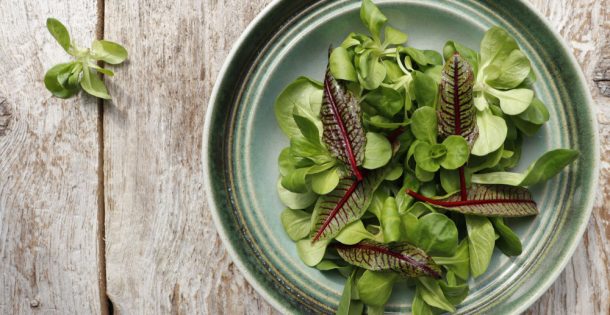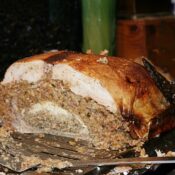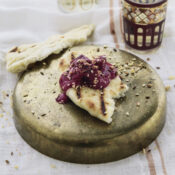Salads, dressings, and celery fringe from the 19th-century Post.
—
Remember: Lettuce Must Be Crisp
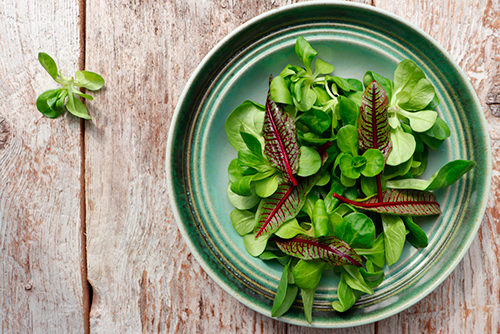
Originally published in The Saturday Evening Post, June 3, 1876
Lettuce is like conversation: It must be fresh and crisp, so sparkling that you scarcely see the bitter in it. Lettuce, like most talkers, is however, apt to run rapidly to seed. Blessed is that sort which comes to a head, and so remains, like a few people we know, growing more solid and satisfactory and tender at the same time, and whiter at the center, and crisp in their maturity. Lettuce, like conversation, requires a good deal of oil, to avoid friction, and to keep the company smooth — a pinch of attic salt, a dash of pepper, a quantity of mustard and vinegar, by all means, but so mixed that you will notice no sharp contrasts, and a trifle of sugar. You can put anything, and the more things the better, into salad, as into conversation; but everything depends upon the mixing.
Vegetable Salad
Originally published in The Saturday Evening Post, May 16, 1868
It is a great mistake to soak lettuces for salad; the process materially injures their flavor; though still, if your vegetables be at all stale, you had better let them lie in water for an hour or two; and small salad, such as cresses, radishes, etc., require very thorough washing. But a fine, freshly-gathered lettuce should be only well rinsed, shaken and well wiped with a soft cloth, then shred into small pieces.
You can add, according to taste, cresses of any kind, or radishes scraped and sliced; also, beet-root, and, if desired, spring onions, chopped fine. A few fresh-gathered leaves of green mint are by many people esteemed a great improvement. If you do not care to make a regular salad dressing, just season lightly with pepper and salt, throw in one tablespoonful of best salad oil, two of vinegar, and a large teaspoonful of moist sugar. Mix all well together with the salad-spoon and fork, and serve.
Lettuce, Sorrel, or Dandelion Salad
Originally published in The Saturday Evening Post, March 16, 1867
This is always sent to the table with the roast piece or with the chicken. First wash the lettuce — and be particular to drain it of all the water, for good salad cannot be made with water. A tablespoonful of oil, and half as much of vinegar; salt and pepper to taste; stir thoroughly.
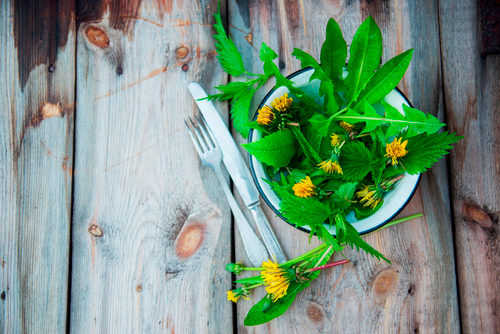
Professor Blot incidentally remarked that sorrel, a sour-ish vegetable, is the best thing to eat in the spring when prepared similar to lettuce. The dandelion also is an excellent field plant. The latter was designed for our use. In the order of nature, it was the first palatable vegetable that comes forth in the spring season, and man should eat it.
Congress Salad
Originally published in The Saturday Evening Post, July 15, 1865
One day at a chowder party on Nantucket Beach in Massachusetts, I took such material as we had, or could get, and improvised a salad — the grains from two ears of green corn boiled and mashed on a flat stone; half a dozen scarlet radishes whittled into thin shavings; a handful of wild sorrel (Rumex acetosa); the liquor from four great live clams; a gill of vinegar; and mustard, curry, pepper ad libitum.
There were four live Congressmen of the party — among the Sage of Marshfield, who flattered me by pronouncing the mixture the best made-up dish he ever tasted, and christened it Congress Salad.
Winter Cabbage Salad
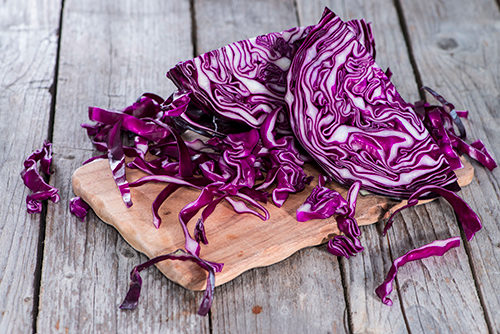
Originally published in The Saturday Evening Post, January 7, 1871
Red cabbage makes a delicious winter salad when lettuces, etc., are scarce, and is very pretty. Cut up half a head of raw, red cabbage into small shreds. Mix with it 4 heads of white celery, also cut small. Decorate with sliced beet-root and the white of a hard-boiled egg. Put half a pint of vinegar on to boil, beat up the yolk of an egg with a little salt and cayenne, pour the boiling vinegar on the yolk, stir it well, and pour it over the cabbage. This is nice with roast beef, hot or cold.
Radish, Celery, or Onion Salad
Originally published in The Saturday Evening Post, April 5, 1873
Radishes. Peel tender radishes, grate them, add salt and vinegar, if desired. This manner of preparing radishes is more healthy for all; especially for persons who have poor teeth, and children who do not take lime to masticate their food. Winter radishes grate nicely, and will be found a fine relish, when fresh salads cannot be obtained.
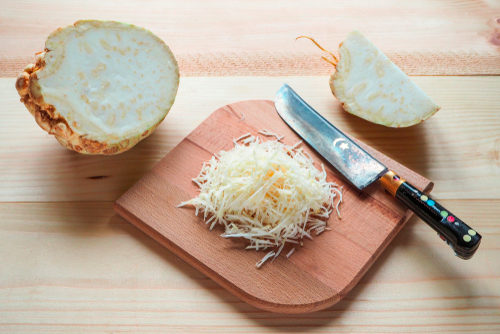
Celery. Take the blanched celery, cut it as fine as possible, add salt, and send it to the table, where vinegar and egg can be added, if desired. This salad should be served as soon as prepared, as it will be apt to turn brown; ornament the dish with green celery leaves.
Onions can be prepared in the same manner, and will make a fine salad for those who relish them.
How to Dress a Salad
Originally published in The Saturday Evening Post, May 21, 1864
“The vinegar used in salad should always be wine vinegar, not pyroligneous acid.” This latter is the usual kind of thing met with, and is abominable. Chaptal, the great French chemist, directs that “the salad should be saturated with oil, and seasoned with salt and pepper, before the vinegar is added. It results from this process that there never can be too much vinegar, for, from the specific gravity of the vinegar compared with oil, what is more than needful will fall to the bottom of the salad bowl. The salt should not be dissolved in the vinegar, but in the oil, by which means it is more equally distributed through the salad.
“The Spanish proverb says that to make a perfect salad there should be a miser for oil, a spendthrift for vinegar, a wise man for salt, and a madcap to stir the ingredients up and mix them well together. The proverb is perfect with the exception of the last member of the sentence. A patient and discreet man, a painstaking and careful man or woman should be entrusted with the duty of mixing the salad with its seasoning.”
How to Fringe Celery for Garnishing
Originally published in The Saturday Evening Post, January 13, 1866
Take the outer thick white and green stalks, cut them about a finger’s length, then select a good large new cork, stick it full of coarse needles, and carefully draw each piece of celery over the cork, leaving at the end about an inch of the celery stick to remain unfringed; when all the fibrous parts are separated, lay the celery for a couple of hours in cold water to curl and crisp. This is a beautiful garnish for salads, if laid on thickly.
Scotch Sauce
Originally published in The Saturday Evening Post, June 29, 1867
Bruise down the yolks of two hard-boiled eggs in a basin; add a large spoonful of mustard; rub them together with 1 tablespoonful [each] of catsup and tarragon, 2 [tablespoons] of white wine vinegar, and a teacupful of thick cream. These must be all thoroughly mixed together, and, after the salad is cut and arranged in the salad-dish, pour the dressing equally over the whole of it.
Vinaigrette (Raw Egg Optional)
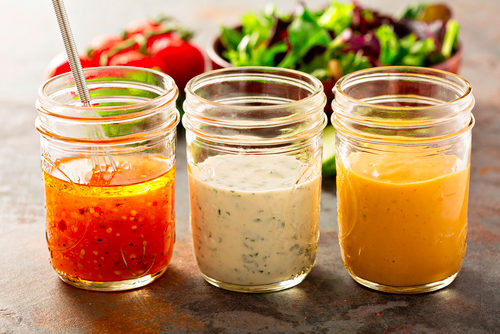
Originally published in The Saturday Evening Post, May 16, 1868
The essential ingredients are: good cider vinegar, pure mustard, fresh eggs, and sweet oil made of olives — not of lard. Begin with a teaspoonful of dry mustard in a soup plate; add nearly an equal quantity of salt, a little vinegar, and beat to a paste; then add the yolk of a fresh egg, and after thoroughly rubbing and mingling all with a silver fork or spoon, add about a half tablespoonful of sweet oil, and stir until it is smooth. It will probably then have a shining, greasy look. Add a few drops of vinegar, and it will, when stirred, at once thicken up, and lose the greasy look entirely.
When all is smooth and uniform, add more oil, and again, a very little vinegar, if necessary, to produce the same effect. Our rule is to add as much oil as we can cause to be entirely taken up, and to stop before either the addition of more oil or vinegar will cease to thicken. The dressing should be smooth as whipped cream, and this, indeed, thoroughly beaten up with the white of the egg or eggs, is an addition to the dressing which increases its delicacy and deliciousness.
In a good salad dressing the oil loses its oiliness, but pervades the whole with its flavor, and while the sharpness of the mustard, salt, and vinegar, entirely disappear, each ingredient adds a peculiar piquancy to the agreeable compound, which by contrast only heightens the crispy freshness of the lettuce, and brings out its flavor. The egg may be omitted, and you will still have a nice dressing, if the oil is good.
Lettuce, watercress, endive, and celery, make fine salads. Dandelion, sorrel, and some other plants are occasionally used. Salads are very appetizing, and may well have a place every day upon the table.
French Salad Sauce
Originally published in The Saturday Evening Post, April 16, 1870
Boil one egg hard. When cold, remove the yolk, put it into a basin, and bruise it to pulp with a wooden spoon. Then add a raw yolk and a teaspoonful of flour, a small teaspoonful of salt, a quarter of pepper. Then add half a spoonful of vinegar, stir it round, pour over a tablespoonful of oil by degrees, then a little more vinegar, and two more of oil, until 8 teaspoonsful of oil and 3 of vinegar are used. Season with half a teaspoonful of chopped onions, two of parsley, and a pinch of cayenne. It will keep sometime if properly cooked.
Become a Saturday Evening Post member and enjoy unlimited access. Subscribe now
